With 3-0 wins to open the season, Atlético Madrid and Villarreal enter their week two clash with momentum and high expectations.
For the Madrid side, there’s a hope that their early performances will keep them on pace with the other title contenders, particularly Real Madrid and Barcelona. For Villarreal, last year’s Champion’s League semi-final run has them targeting a top-four finish in La Liga.
This may only be week two, but the stakes are high as Atlético Madrid host Villarreal on Sunday as each club looks to avoid dropping points early in the season.
This tactical analysis offers a preview of La Liga’s showcase match for the weekend. We’ll look at each clubs’ expected line-ups, defensive structures and in-possession tactics.
Expected lineups
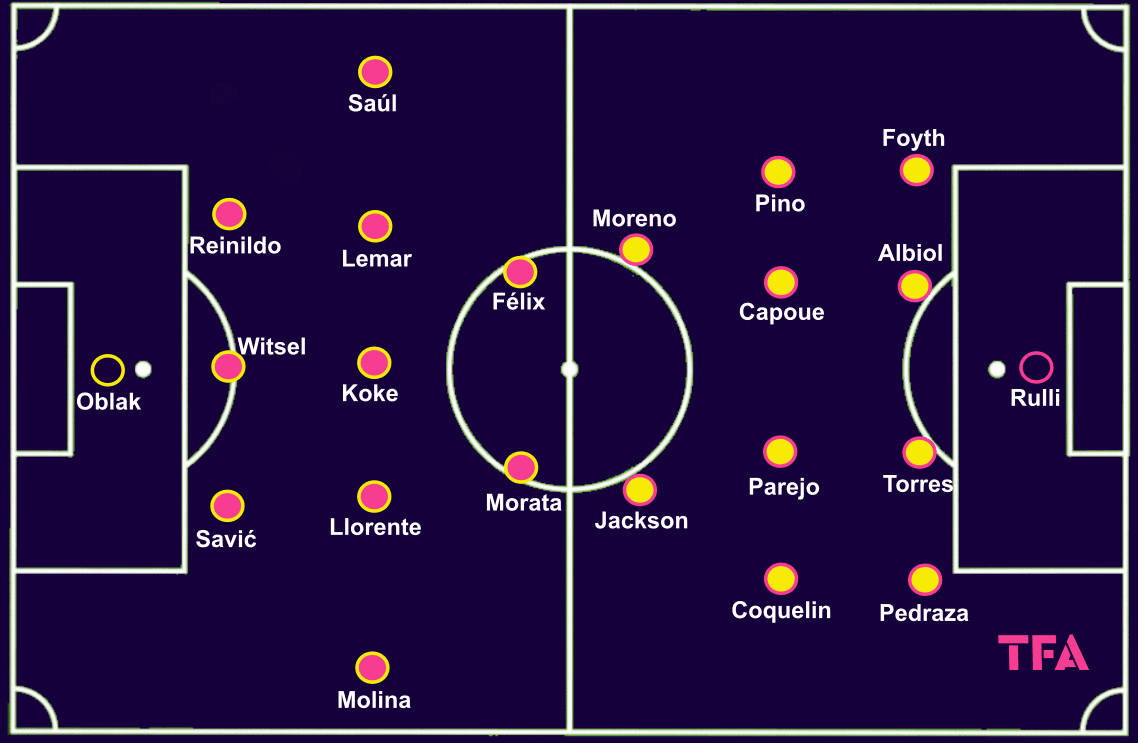
Diego Simeone’s side is likely to roll out in his new system of choice, the 3-5-2. Jan Oblak will get the nod in goal with a back three of Stefan Savić, Axel Witsel and Reinildo Mandava, though he could make way for José Giménez if the Uruguayan is healthy. In midfield, look for Saúl and Nahuel Molina on the wings, then Marcos Llorente, Koke and Thomas Lemar centrally.
For Unai Emery, expect Gerónimo Rulli in goal. His backline will likely consist of Alfonso Pedraza, Pau Torres, veteran Raúl Albiol and Juan Foyth. In midfield, look for Dani Parejo and Étienne Capoue as the pivots, flanked by Yeremi Pino and Francis Coquelin. Up top, Gerard Moreno is locked into the starter role and could be joined again by Nicolas Jackson.
Defensive orientations
Simeone is known for his ultra-defensive tactics, but Atlético Madrid struggled last season, tying for 10th in goals conceded. A clean sheet to start the year will surely bring Simeone some relief. His side may not have the defensive muscle of previous Atlético teams, but their 3-5-2 produced good results last week against Getafe and has served them well since the switch from Simeone’s traditional 4-4-2 last season.
Last week’s match against Getafe also saw Atlético exert their influence through their high press. When Los Rojiblancos look to engage the opponent high up the pitch, that 3-5-2 morphs into a 5-3-2, though there is some flexibility within the midfield line. In general, the opposition’s nearest midfield targets will be man-marked to prevent easy, short-range distributions into midfield.
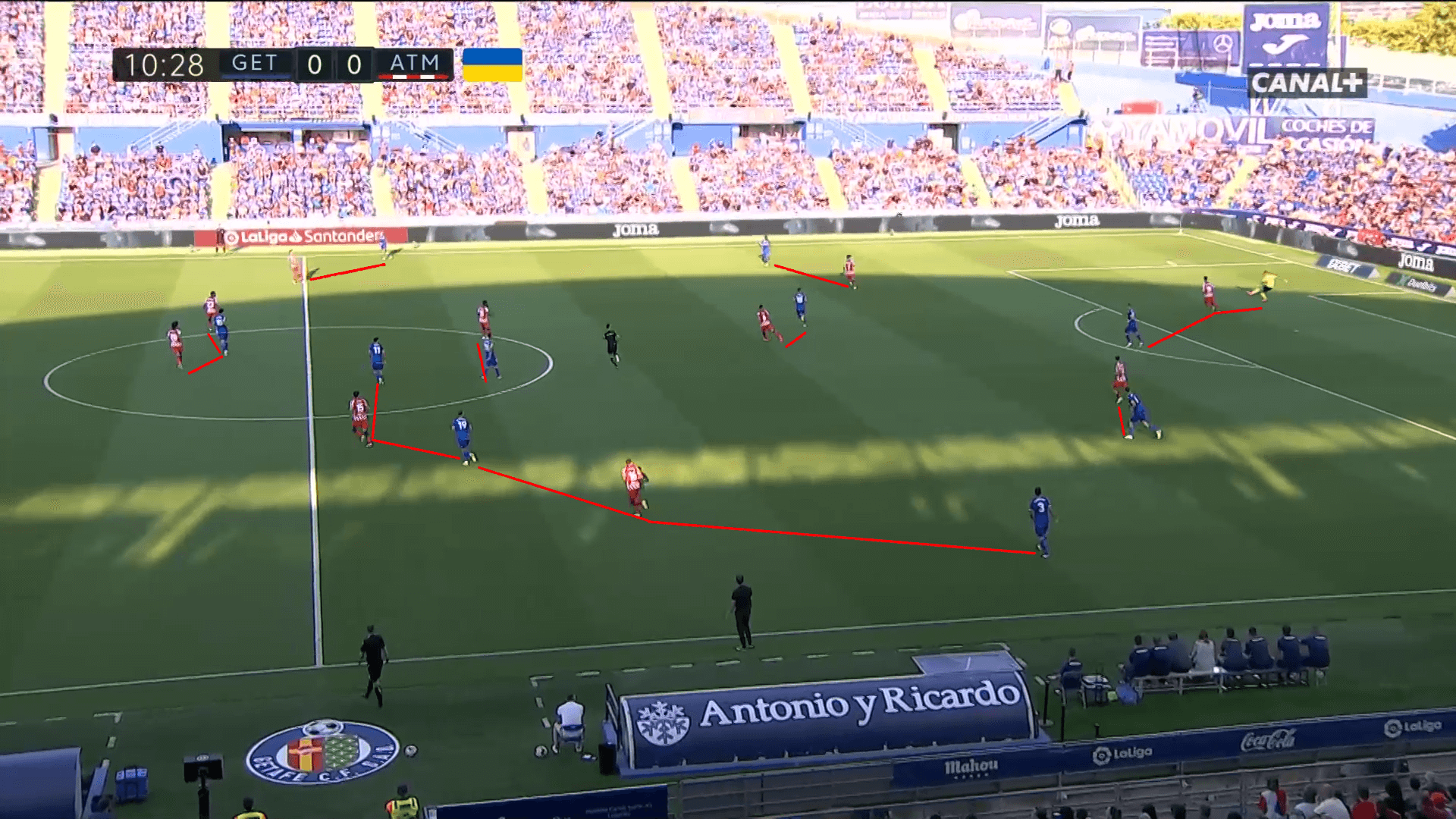
One of the midfielders may also advance into the forward line if help is needed. As we see in the image above, players have clear marking responsibilities while the wide midfielders support their central teammates by taking up a starting positioning in the half-space. By sliding further inside, the wingers offer first and second ball support should the opponents attack centrally while also encouraging the opposition to play lower-risk passes into the wings. Once they take the bait, Atlético can make the pitch vertically and horizontally compact.
When Getafe advanced into the Atlético Madrid half of the pitch, Atlético maintained their 5-3-2 shape. The priority was numbers behind the ball and central numerical superiority to push Getafe wide and reduce their attacks to crossing attempts.
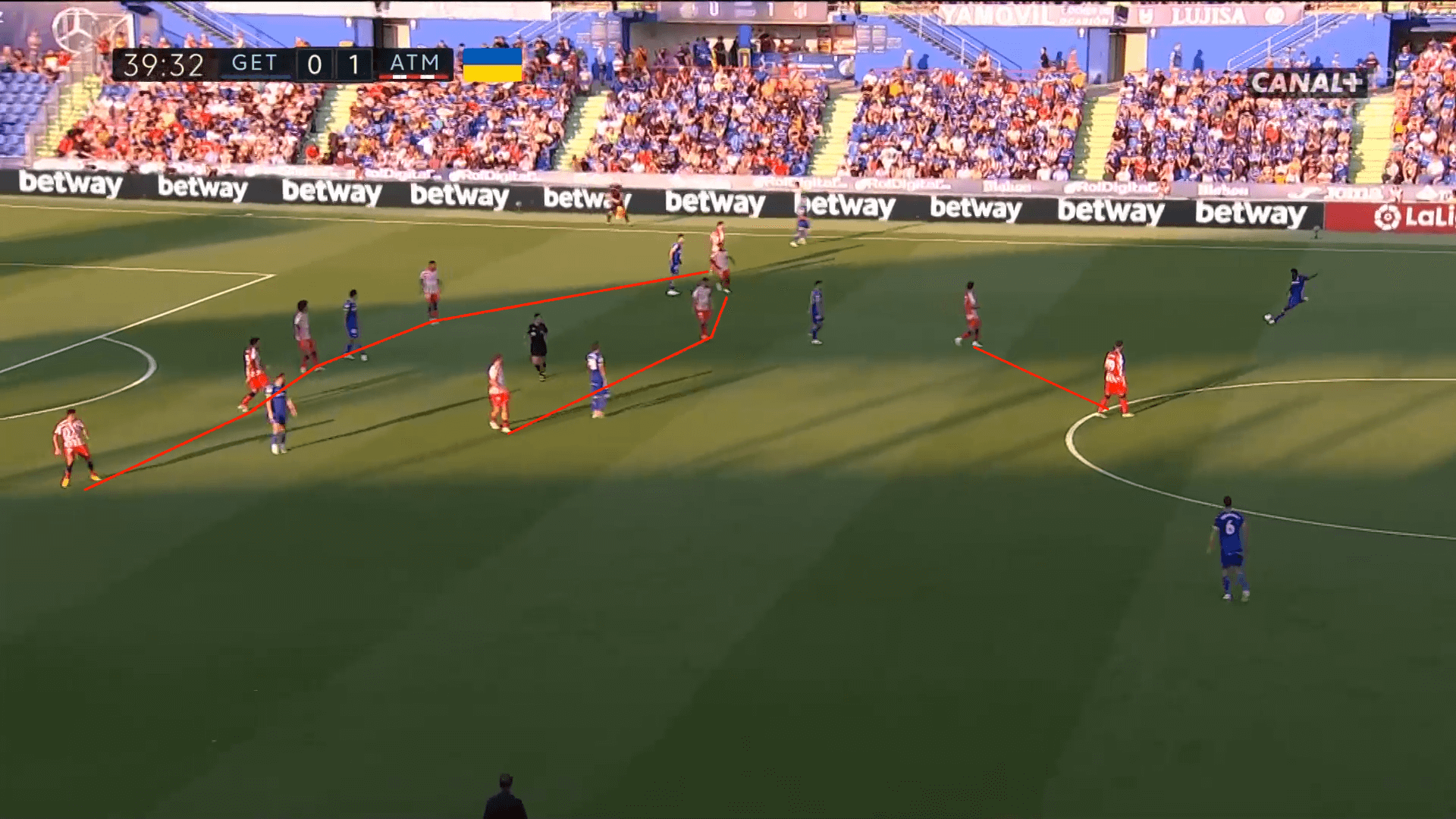
Over the past few seasons, the matchup between these two clubs has seen possession split fairly evenly when the match is played at Wanda Metropolitano. When possession is lopsided, it’s typically because Atlético has the lead and has conceded the ball to Villarreal. Unless Atlético has at least a two-goal cushion by halftime, which is unlikely, expect the run of play to be fairly even on Sunday.
Working under the assumption that Atlético Madrid will look to enjoy attacking spells in the run of play, let’s look at Emery’s defensive tactics.
While the Champions League viewer may remember a Villarreal side that dropped into a low block and played pragmatically, much like a classic Simeone side, La Liga Villarreal is a different animal. It doesn’t matter if they’re playing Atlético Madrid or Real Madrid, they will high-press opponents. Los Rojiblancos will surely expect that tomorrow.
As Villarreal engage in the high press, they will attempt to funnel opponents into the wings. Within their 4-4-2, the two forwards will block central passing lanes and place pressure on the opposition’s centre-backs and goalkeeper. The typical trigger is a pass played into the opposition’s outside backs. Once that happens, Villarreal quickly slide their lines and often take a man-oriented approach near the ball. Any players who fall outside of the first and second defender roles will typically have a zonal orientation.
In the image below, we see an instance in which Villarreal has successfully funnelled the Real Valladolid build-up into the right-wing. As help arrived, so did a swarm of yellow shirts. The yellow lines indicate the marking responsibilities and the white line shows the pass that was played. The pass was intercepted and the high recovery resulted in Villarreal narrowly missing a through ball into the box.
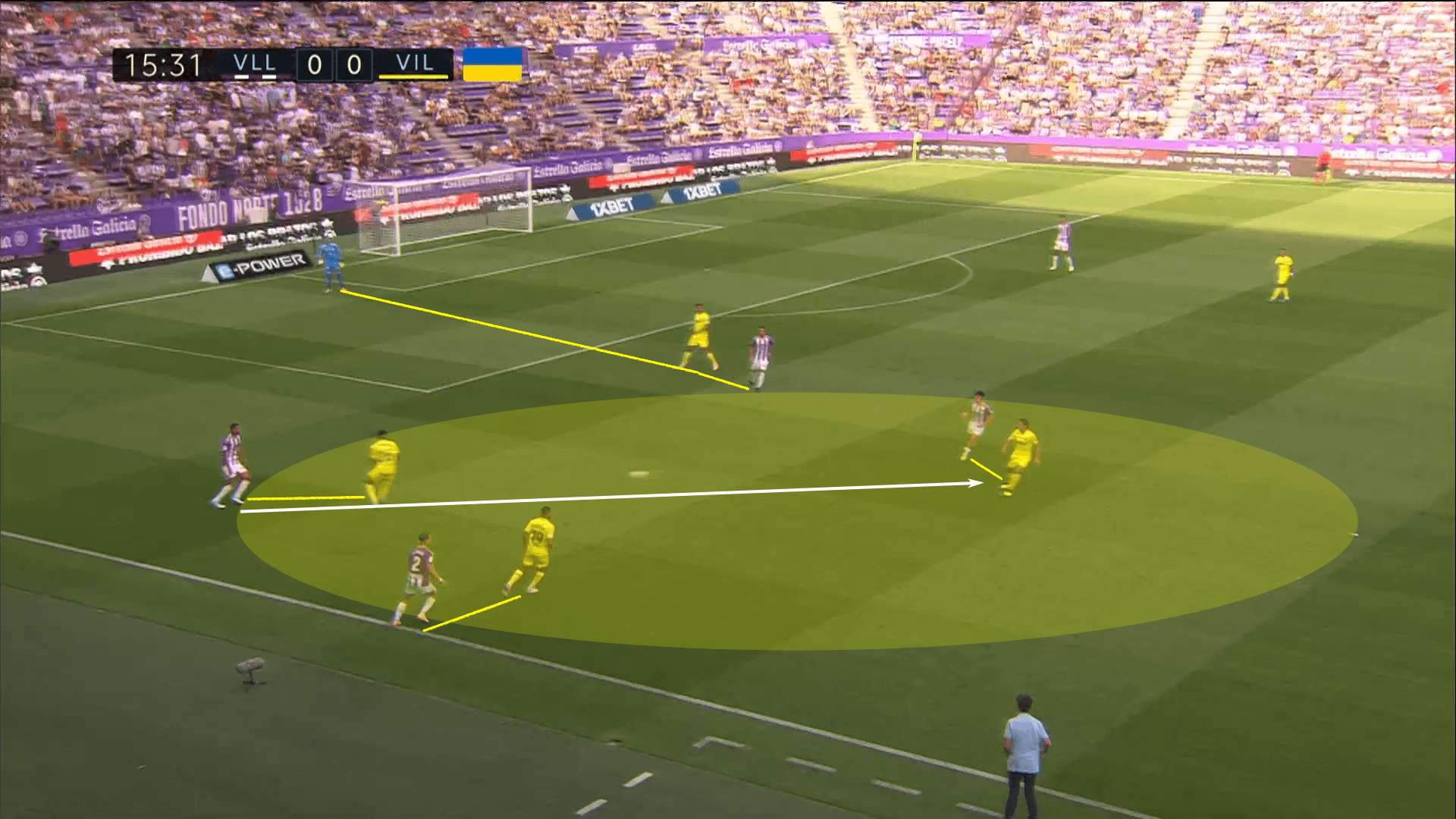
After a successful build-out or if Villarreal is looking for a change in tempo, they will drop off to a mid-block with a midfield line of confrontation. Still, within their 4-4-2, Villarreal will get numbers behind the ball and play with very narrow banks of four. The objective is to bait the opposition into a long switch of play. As the ball travels, Villarreal will make up ground, as seen below.
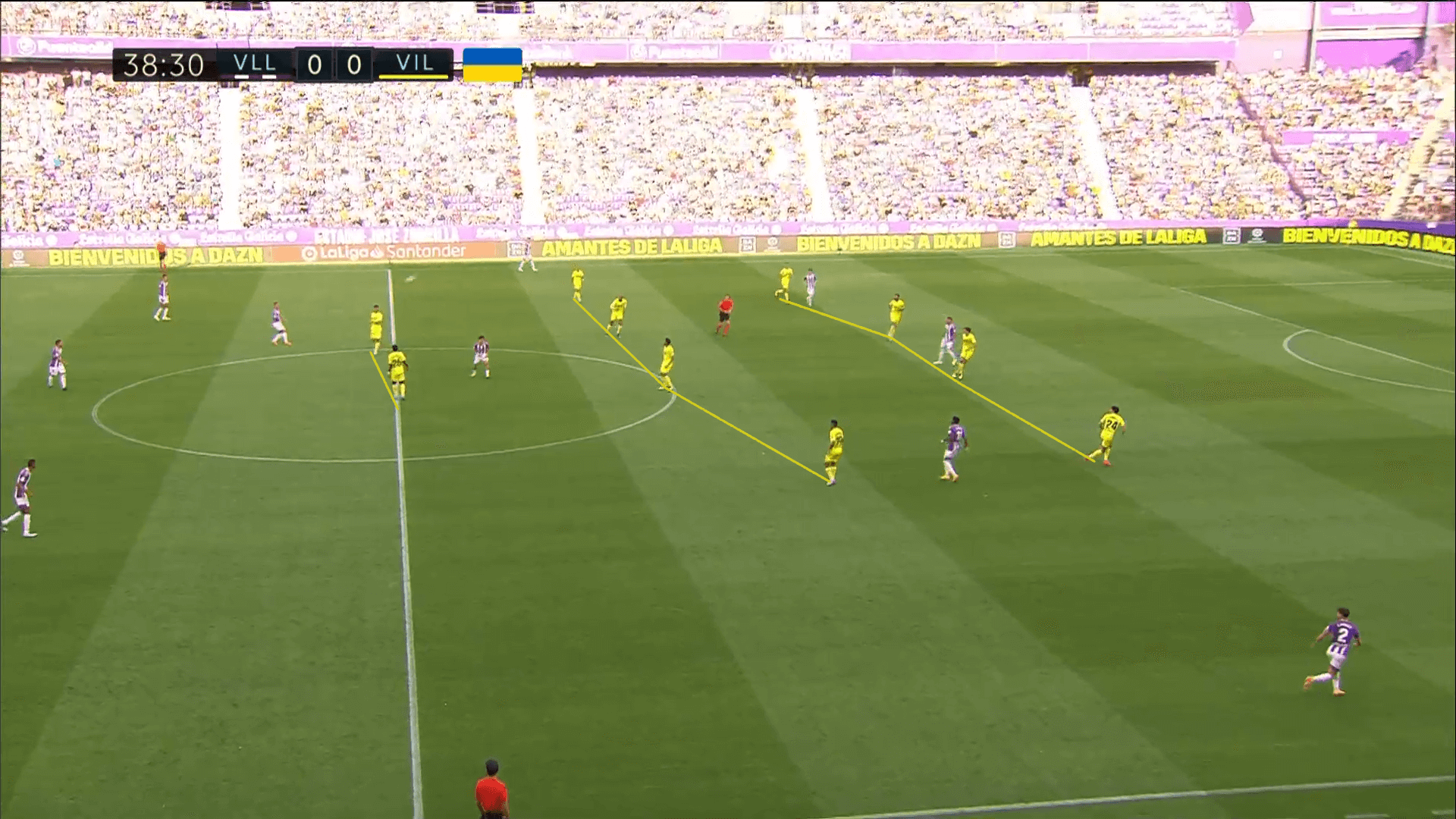
Villarreal can drop into a low block if needed, but, at least in La Liga, they’re more likely to engage opponents higher up the pitch. Look for that aggression and confidence in their defensive structure in this match.
Controlling the centre
With the analysis of the traditional defensive powerhouse and then one of last season’s top defensive teams, let’s move to the attacking side of play. We’ll start with Villarreal.
Typically, when you think of a 4-4-2 with a flat midfield, the attacking objective is to use numerical superiority in the wings for ball progression while consistently getting at least two players into the box to meet crosses. Villarreal’s midfield may be flat in defence, but they’re highly fluid when the team is in possession. At times, we will see their flat midfield, but it’s more common to see the two wingers pinch inside in more fluid roles. They may form a box with the two central midfielders or even stay slightly wider to form a hexagon between themselves, the two centre-mids, and the two forwards.
We got a great glimpse of their attacking tactics during the Real Valladolid match. Starting from a goal kick, the first image shows a typical 4-4-2 build-out. The centre-backs are deep to direct the build-out while the two outside-backs take up wide positions. Meanwhile, the two central midfielders are stationed between the Valladolid forward and midfield lines.
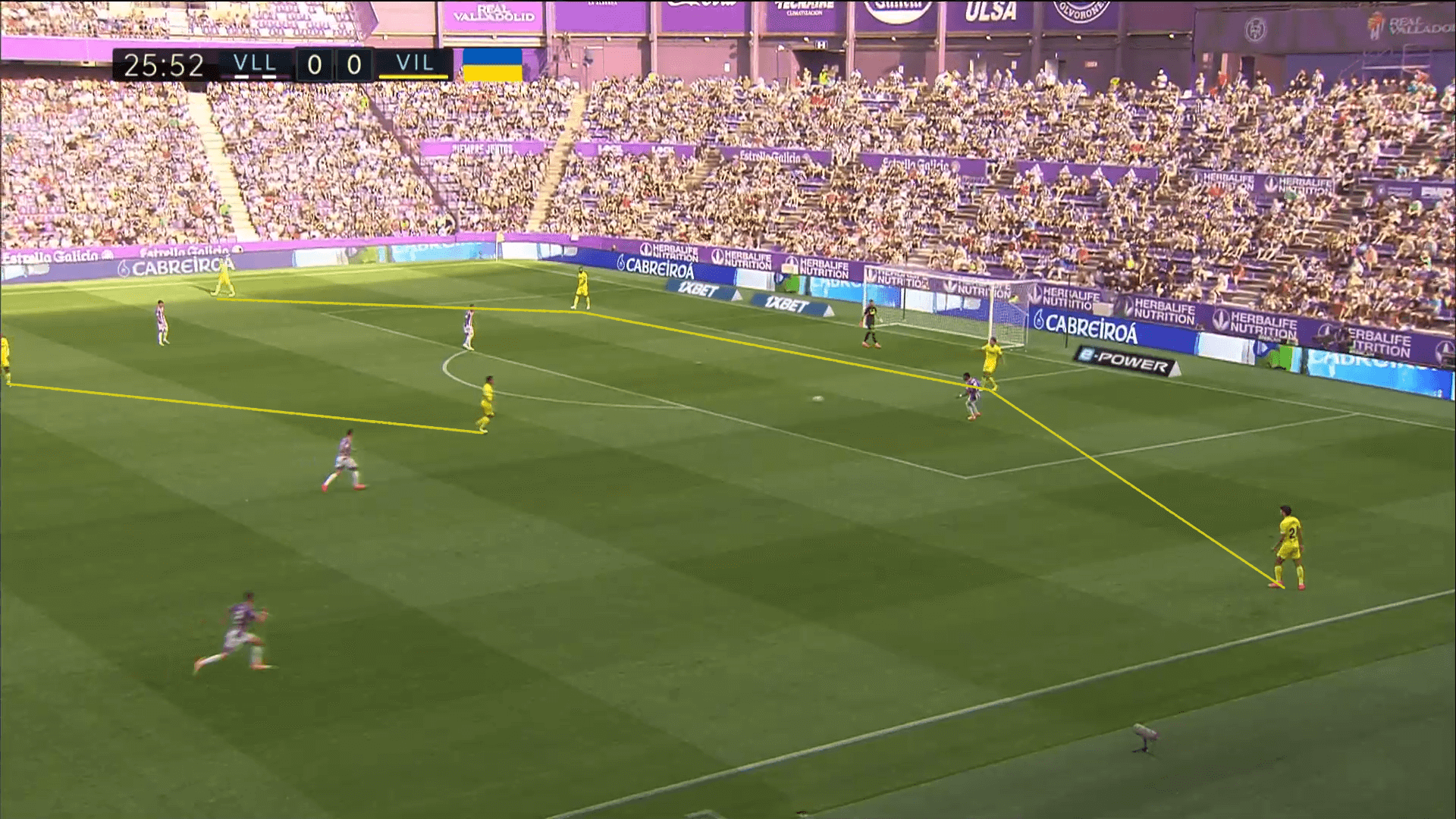
As El Submarí Groguet progress up the pitch, we get a better view of their midfield and forward orientation. In this particular instance, the midfielders formed a box. The result was central dominance. That forced Real Valladolid to pinch their wingers more centrally, creating space for the outside-backs to progress through the wings.
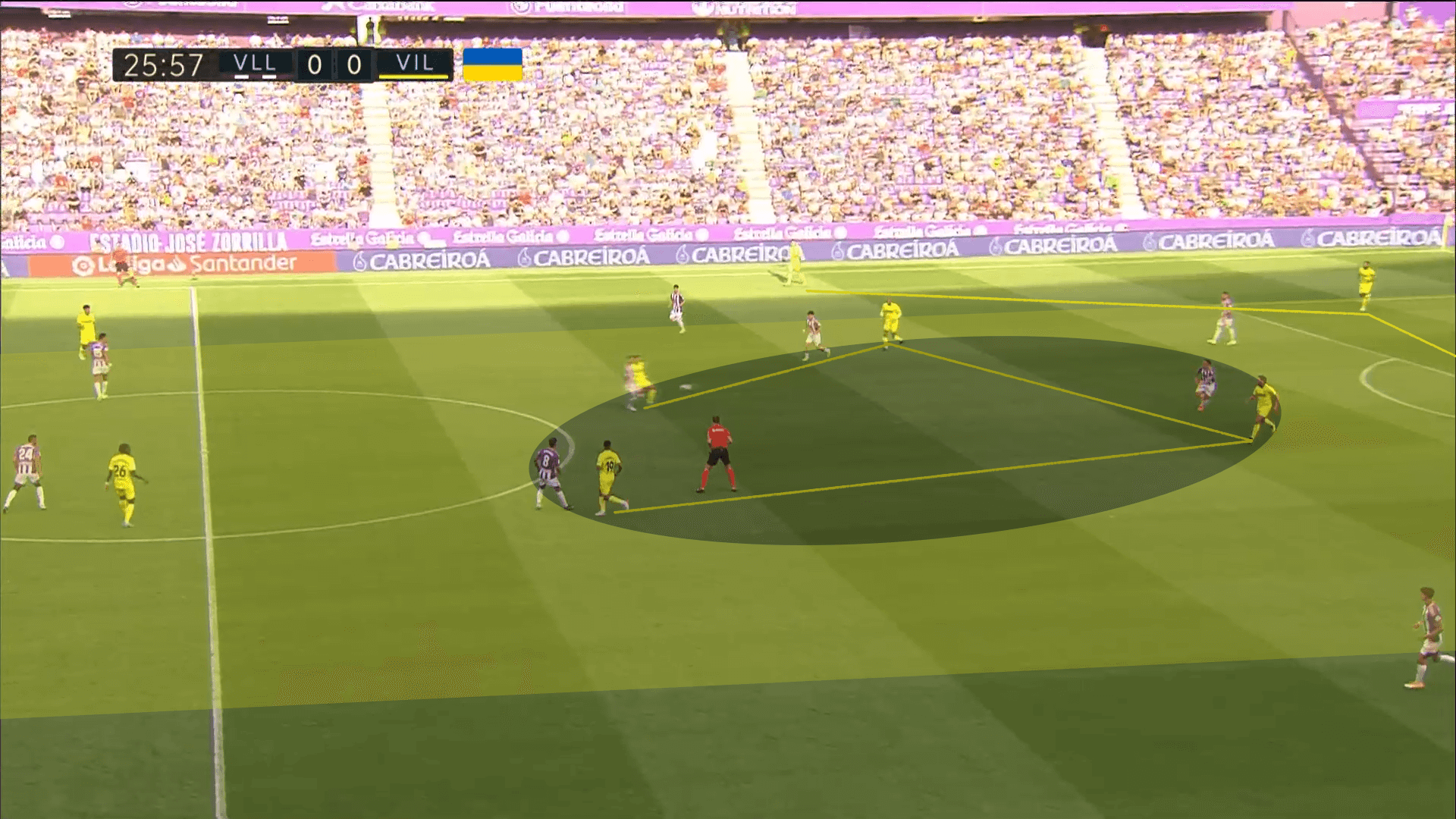
One of Villarreal’s in-possession strengths is the ability to constantly put the opponent’s defensive structure off balance with fluid position play. As opponents are more heavily concentrated centrally, Villarreal attacks through the wings. If they are vertically compact, the Yellow Submarines take up deep build-out positions. Their analysis of the opposition’s defensive structure and precision in their decision-making forces opponents to adapt for 90 minutes.
When opponents are unbalanced centrally, Villarreal has the central playmakers to play over the press. Whether it’s Pau Torres, Raúl Albiol, or Dani Parejo, they can find a way to break the opposition’s press with a single pass.
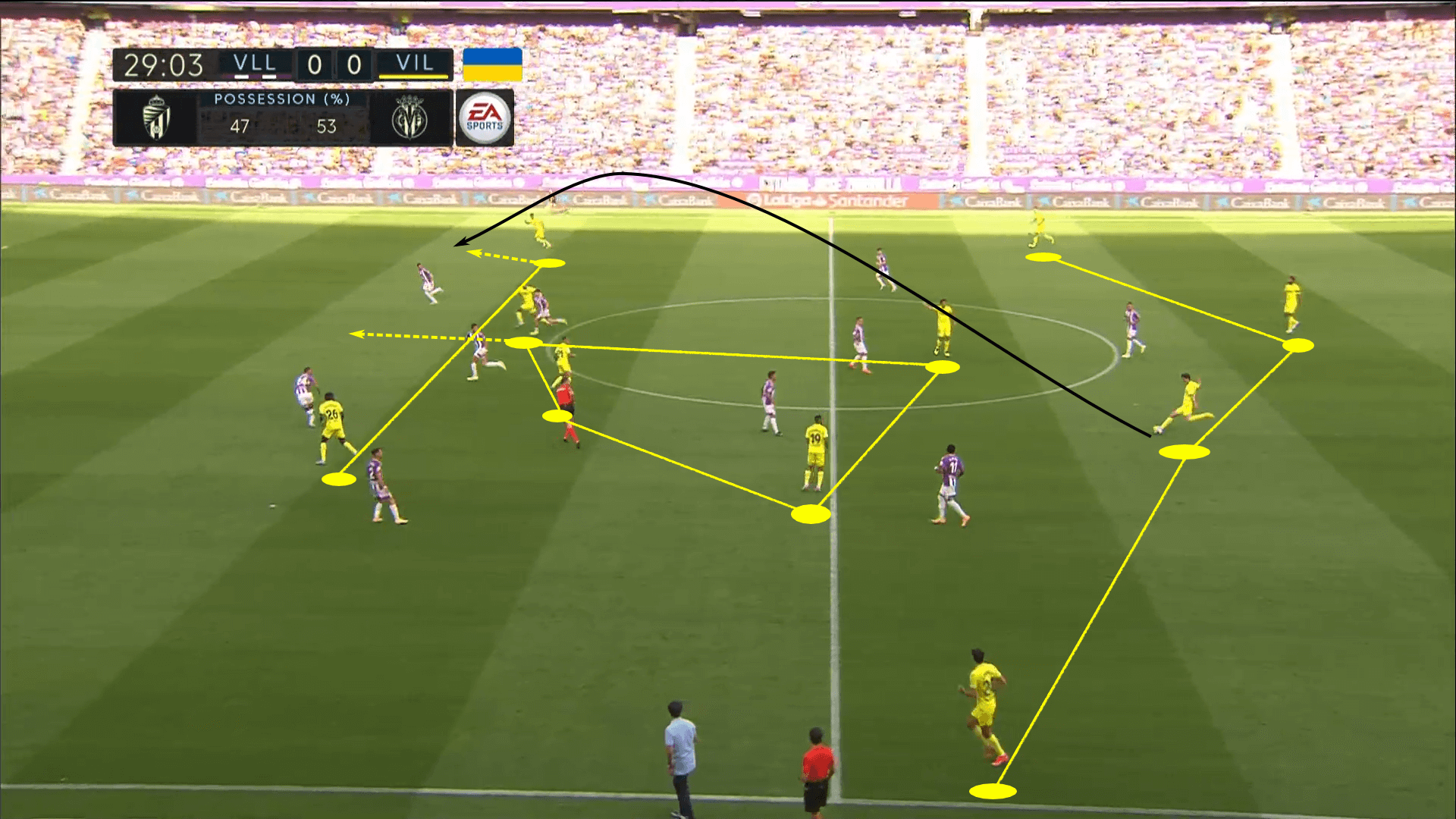
Look for Villareal to take advantage of Atlético Madrid’s 3-5-2 by pinching the wide midfielders more centrally. Central superiority will either force Atlético Madrid to pinch their wingbacks further inside to support, creating space for Villareal’s progression through the wings, or allow Villarreal to attack centrally if no change is made.
Atlético’s 2-3-5 attacking structure
The past couple of seasons have seen any number of significant attacking options arrive at Atlético Madrid. There was talk of a tactical evolution for Diego Simeone as he looked to produce more fluid attacking football. Looking specifically at the defensive results the club achieved last season, the deemphasis on defensive tactics and pragmatism may well be warranted.
But what does that look like with the current set of players?
With the change to a 3-5-2, Simeone has essentially committed one more player to the deepest line of defence while also giving his team another central midfielder when in possession. Perhaps the top principle to point out is that Atlético Madrid will use a 3-2-5, or some near variant, when in possession. That numeric attacking structure is very much in line with the top attacking clubs of today.
On the face of it, the 3-2 among the first two lines is a pragmatic means of rest defence structure that helps fight off opposition counterattacks. With that security against transitional moments, the line of five is afforded more freedom.
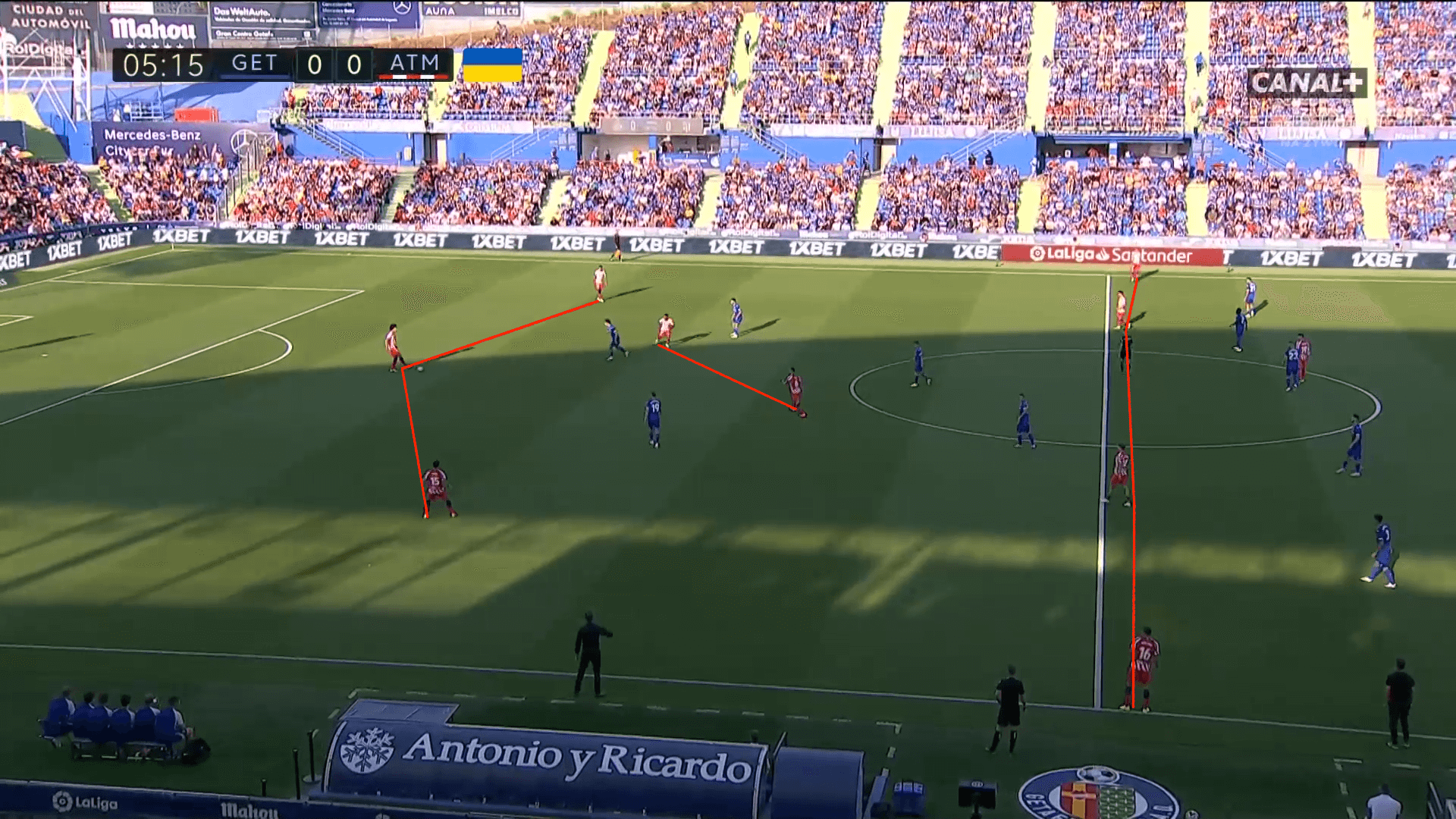
In Atlético Madrid’s case, we may see five players higher up the pitch, the striker in a higher position than the other four or wide overloads to create 2v1s. They may also stretch the opposition’s backline high, disconnecting them from the midfield line, so that a player like João Félix can drop between the lines to offer a line-breaking pass.
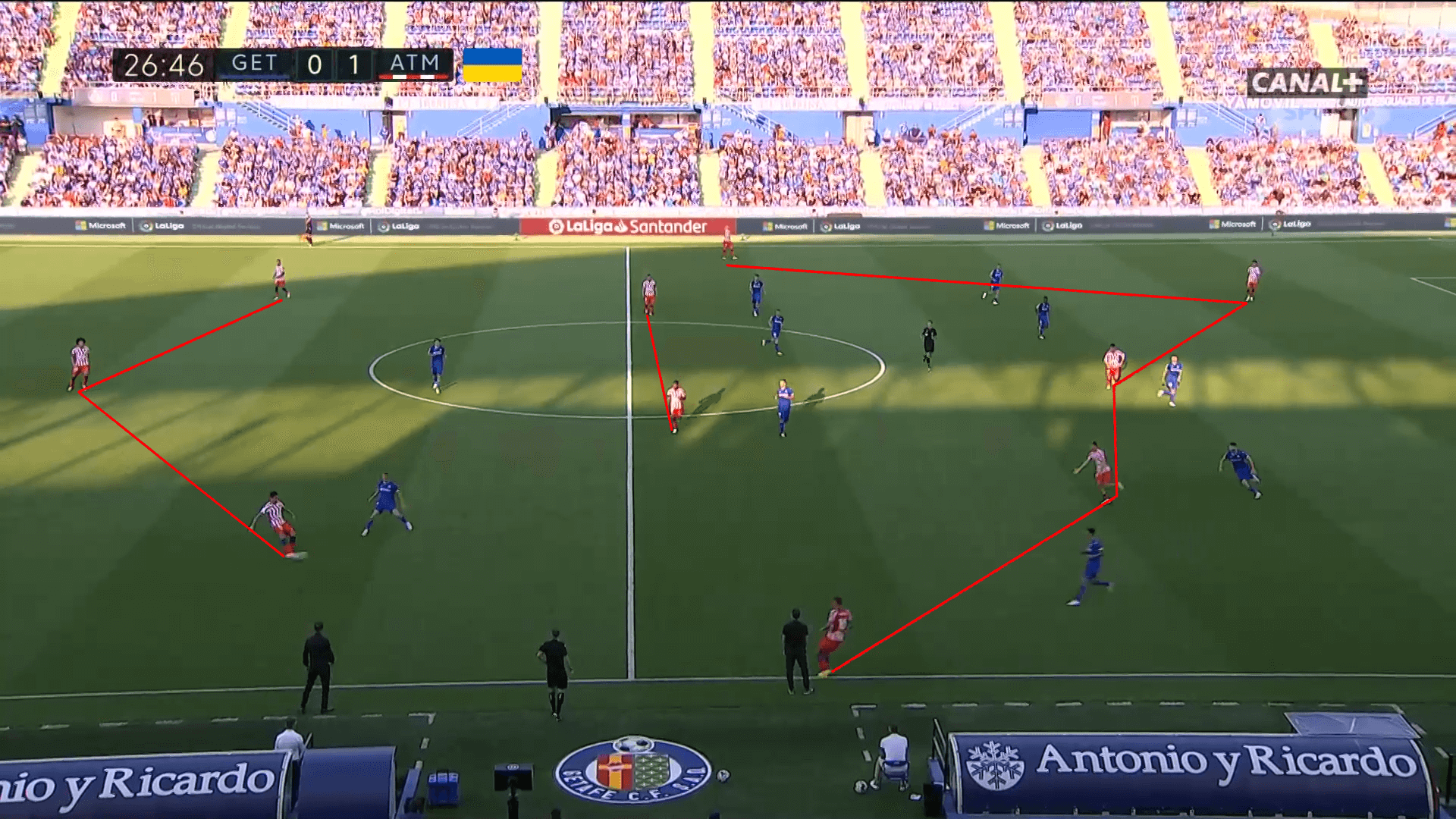
Ultimately, the line of five is highly adaptable. Their tactical fluidity allows them to move off of each other to create cues for progression. They’ll offer some form of superiority that signals the players in the 3-2 to move the ball higher up the pitch and increase the tempo of the attack.
Their ability to beat Villarreal’s high press and sustain pressure on the backline is vital. Should the two central Villarreal midfielders remain deep to support the backline, the two wingers may have to pinch inside to help with Atlético Madrid’s line of two midfielders. If Atlético Madrid can unbalance the Villareal press, finding a way to disorient the two wingers, they’ll find it easier to build out and potentially catch Villarreal off guard when the attacking tempo changes.
Conclusion
Yes, this is an early-season match, but when European hopefuls collide, the points simply seem more valuable. Slipping up in the early stages of the season is certainly not a death sentence but does limit the season’s outlook.
Two of La Liga’s top clubs collide, and it is certainly a battle for all football fans. When they meet, it’s almost a certainty one of the two sides will score two goals. With that in mind, we’ll choose a 2-1 victory for the hosts.





Comments